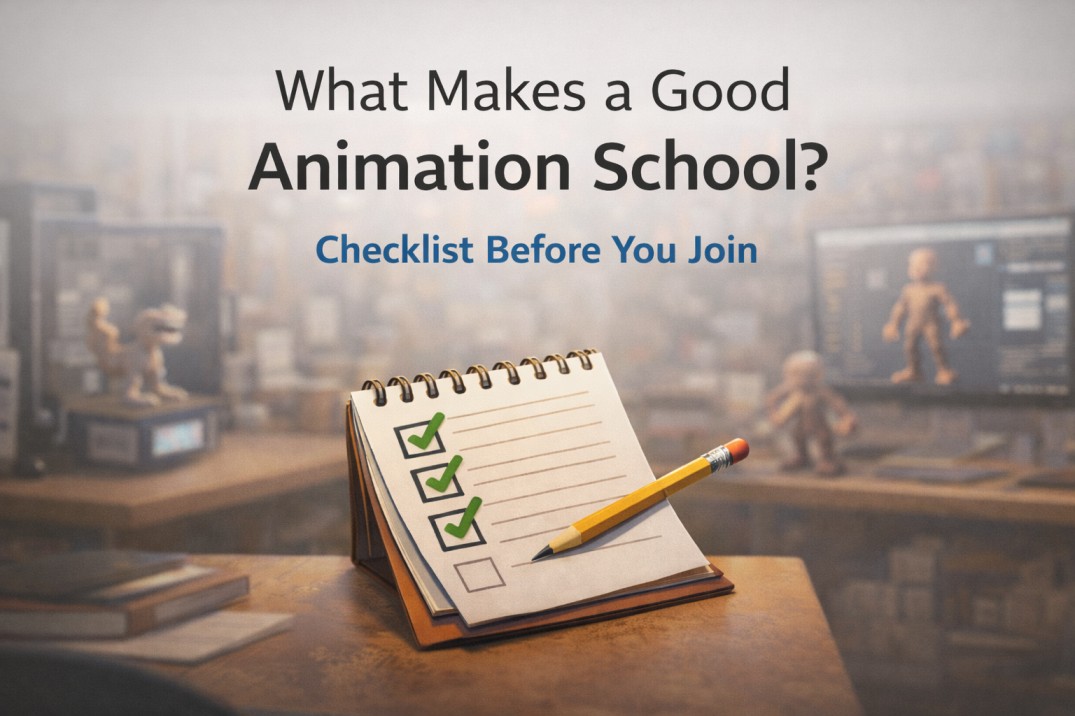How to Become an Animator: Skills, Education, and Career Pathways
Were you intrigued about how your favorite cartoons walked and talked? Do you have a way with art and want to become an animator after school? All you have to do is follow some simple steps and continue to work on your art.
The animation industry is growing quite rapidly. It hires hundreds of new professionals each year in India. As technological innovations are introduced in different fields, animators are being employed by a lot of industries. From tourism, medical, and fashion industries to entertainment and advertising, skilled animators can have a rewarding career anywhere.
This article will tell you all the steps you need to follow to become an animator and make a mark in the industry. It will take you through the skills you need and the available courses so you can start working towards your dream career today.
1. Develop the Essential Skills Needed to Become an Animator
Before you join a professional course or opt for some formal training, you can work on some of your skills. These would help you understand animation better. Basic skills are also useful for the Design Aptitude Tests and other Entrance Examinations that you would need to qualify for. You can use the resources available online to develop some basic foundational skills.
- Artistic Foundation – Get familiar with drawing for animation. You don’t have to be a professional artist to become an animator. Learn the basics of sketching, and drawing different scenes and characters. You can practice live drawings and quick sketches to work on your skills.
Read Also: Guide to a Career in Animation – Top Courses, Skills, Fees, Job opportunities
- Learn Some Basic Terminologies – Learn some technical terms and how they are used. You can find articles and videos related to your field to know more. These could be useful in keeping up with the lessons when you join a course.
- Get Acquainted with Digital Tools – The animation industry relies heavily on digital tools. While some of these are quite advanced, you can start with some basics. Get software that is available for free or offers a free version for students. Software knowledge would help you get ahead of the curve when you join an institute. It would also help you start with internships early in your animation career.
2. Get a Professional Training
To kick off your career as an animator, you need to start by getting some professional training. You can pursue a degree/diploma followed by specialized courses.
- It would deepen your knowledge of animation and help you master skills
- You will understand how the industry works
- You can meet professionals and network with them
- The curriculum would provide the required industry experience through internships and workshops
- You will learn how to develop your style and work on a personal brand
- Structured courses would guide you through the process of developing a strong portfolio.
You can enroll in these courses based on your interests. Research the available courses before you finalize one.
- Most Undergraduate courses would require you to complete your schooling (10+2) with a minimum of 50% aggregate score.
- Postgraduate courses require a college degree (10+2+3) with 50% to 55% aggregate scores.
- You can then fill out application forms and appear in the various Design Aptitude Tests (DATs) & other entrance exams.
Read Also: Creative Education in the Digital Age: Challenges and Opportunities
| Course Title | Duration | Topics Covered |
| B.Sc. in Animation & VFX | 3 Years | Fundamentals of AnimationWorking with Shapes, forms, textures, & materialsConstruction techniques & character developmentUnderstanding human anatomyUnderstanding vector & raster graphicsDigital ImagingTypes of animationStoryboarding & CompositingScriptwriting & StorytellingMotion Graphics3D visualization and ModellingRelevant Software knowledge |
| B.Des. in Animation Design | 4 Years | Understanding different types of animationHuman AnatomyDesign DrawingScriptwriting & Plot developmentStoryboard development & CompositingCharacter StudyExploring Types of AnimationPre and Post-Production in AnimationDigital MarketingUnderstanding Motion Graphics and SimulationVector and Raster Graphics3D visualization and ModellingVisual EffectsPortfolio Development |
| BA in Animation | 3 Years | Analyzing animated worksDrawing for Animation Animation FundamentalsAnimation TechniquesUnderstanding character designStoryboarding and CompositingDigital tools for animationVFX and Motion GraphicsUnderstanding sound designIntroduction to Graphic Design |
| M.Des in Animation | 2 Years | Advanced animation techniquesModel-making and PrototypingCAD & 3D printingColor engineeringTechniques in broadcast motion graphicsUnderstanding CGI3D Camera Tracking |
| M.Sc/MA in Animation | 2 Years | Exploring character model sheetsUnderstanding animation techniquesUnderstanding 3D visualization workflowBroadcast Motion GraphicsExploring character design & developmentModeling & texture developingUnderstanding CGICamera animationDissecting live-action animation films |
| Diploma in Animation | 1-2 Years | Fundamentals of animationStoryboarding & Color TheoryExploring vector & raster graphicsSpecial effects 2D and 3D compositing3D modelingPost-production techniques in animation |
3. Work on a Strong Portfolio
Portfolios are creative professionals’ best friends. Your portfolio will give recruiters and clients a sneak peek at your work. Remember, you don’t need to include every project you’ve ever done in it. Just include the ones you think are the best and showcase your talent well.
- You can make a short video and compile some of your best clips
- Include characters and their development process
- Focus on the design process to provide a humane touch to your portfolio
- Don’t forget storyboards and sketches
Creating a portfolio is a continuous process. Make sure you regularly update your portfolio to keep it engaging and relevant.
4. Upskill
Creative fields require continuous learning and working on your skills. You can learn new software or specialize in a niche.
- Stay updated on the industry trends and understand how you can incorporate them into your work.
- Master new software and generative technologies.
- Get enrolled in certification and short-term courses.
- Use online resources and tutorials.
Your goal is to both focus on the art form and understand how the industry is evolving. Upskilling would help you stay relevant and find better opportunities.
Read Also: How Artificial Intelligence is Reshaping Animation Production?
5. Industry Experience
Gaining some industry experience is an important step in becoming an animator. It will provide you an insight into how the professional realm works and what industry standards you need to follow.
- You can check for internships online or reach out to the faculty members for mentorship
- Freelance and work with different clients. It would let you work on a flexible schedule while also understanding the nuances of animation.
- Try working as a commissioned animator. It will help you tackle different tasks and become skilled at what you do.
- Collaborate with other professionals for bigger independent projects.
All of this would be helpful for you to get recognition as an animator. Internships, classroom projects, and other industry exposure are great ways to develop a unique style and build a personal brand.
6. Work on Your Unique Style
As an animator, developing a style that helps you stand out can be really beneficial. Start while you are still in your animation institute. Starting early can help you master more styles and work on them better.
- Explore a lot of different styles. While you will learn many of these as a part of your curriculum, you can also go beyond that and learn on your own.
- Experiment with creating characters, rendering techniques, storyboards, and compositing.
- Keep in mind that you will make some mistakes, but don’t let that deter you.
- Focus on variety and work with different kinds of stories and plots. The more variety you have, the more you will be able to understand and develop a unique style.
While you are at it, you need to be really consistent with your style and practice a lot. It would help you perfect the intricacies and work towards building a personal brand.
7. Develop a Personal Brand
Once you’ve figured out your unique style, you should start getting the word out about yourself and build your brand. A personal brand will help you set goals for yourself. It is a great way to position yourself as an animator and find work opportunities.
Read Also: VFX Artist vs 3D Animator – What is the difference?
- The first step towards building a personal brand could be creating a social media profile exclusively for your work.
- Create a website for yourself. You can also use this as a place to showcase all your projects.
- Research relevant information & determine who your target audience would be.
- Build your social media presence by posting artwork that your target audience can engage and connect with.
- Decide on the social media platforms that suit the interests of yourself and your audience. Be regular and consistent with your artwork on these sites.
- You can upload process pictures, brainstorming sheets, and storyboards to make your work look more authentic and humane.
- Make sure you edit your content properly and only post high-quality artwork.
8. Network
Networking essentially means connecting with people from the industry. This could include animators, filmmakers, or other acclaimed professionals. This is an important step in your journey to become an animator.
- Networking will help you understand the industry better and get insights that would help your animation career.
- It is crucial for building healthy professional relationships.
- It’s a good way to learn about the current trends and apply them in your work.
- Networking will help you expand your horizons and find better job opportunities as a new professional.
How do you reach out and make connections with people who work in the industry?
- Participate in contests and attend events
- Join online forums and stay in touch with the alumni of your institute
- Apply for internships and take part in classroom projects
- Collaborate with other animators and graphic designers.
9. Apply For Jobs in the Industry
The animation industry is growing fast. This means animators are in demand in multiple fields. Depending on your interest, specialization, and vacancies, you can turn your career in any direction you want. If you are unsure of what you want to specialize in, you can also explore different options.
Read Also: Unlocking Creativity: The Role of Technology in Modern Education
- Look for vacancies in production companies you want to work with
- Assist acclaimed animators and learn more about the art form
- You can also try your hands in commissioned work or freelancing
- If you want to work on an independent project, prepare a plan and reach out to investors
- Collaborate with other animators and industry professionals to kickstart your career.
- Reach out to HR managers and send over cover letters and your resume.
Conclusion
Becoming an animator requires patience, tenacity, and practice. You must know about the trends, learn new skills, work with the latest software, and much more. As an aspiring animator, the path might seem daunting in the beginning. However, there are multiple career paths that you can choose from. You can freelance, work with a reputed company, or become an entrepreneur. Weigh your options before enrolling in a course, and you are ready.
You can check out the courses offered by AAFT’s School of Animation. The degrees and diplomas in animation offer a well-structured, expert-designed curriculum. These provide students with all the necessary resources and equip them with the skills they need to venture into the industry. Along with state-of-the-art infrastructure, the courses also offer hands-on training and industry exposure that would benefit your animation career in the long run.











